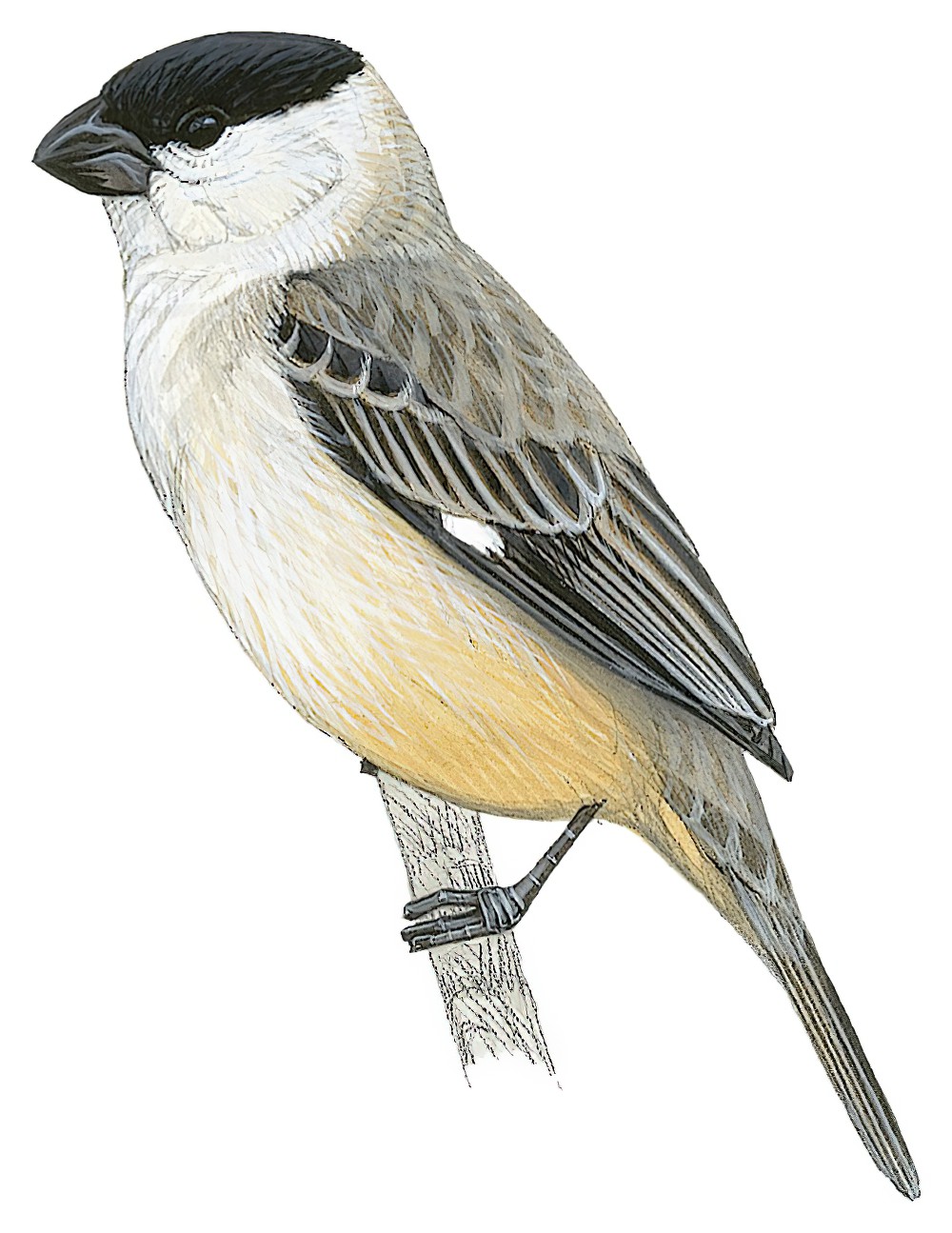Pearly-bellied Seedeater / Sporophila pileata

Pearly-bellied Seedeater
SCI Name:
Protonym: Spermophila pileata Proc.Zool.Soc.London Part III, Meeting of November 22, 1864 p. 607-608
Taxonomy: Passeriformes / Thraupidae / Sporophila
Taxonomy Code: pebsee1
Type Locality: Borda do Mato, eastern Sao Paulo, Brazil.
Author: Sclater, PL
Publish Year: 1865
IUCN Status: Least Concern
DEFINITIONS
SPOROPHILA
(Thraupidae; Ϯ Temminck's Seedeater S. falcirostris) Gr. σπορος sporos seed < σπειρω speirō to sow; φιλος philos lover; "62. Gen. Sporophila 1) Cab. Pyrrhula Tem. part. Spermophila Swains. 1827. ... 1) σπορος sperma." (Cabanis 1844); "Sporophila Cabanis, 1844, Archiv f. Naturg., 10 (1), p. 291. New name for Spermophila Swainson, 1827, preoccupied by Spermophila Richardson, 1825." (Paynter in Peters 1970, XIII, 133) (see Spermophila).
Var. Sporofila, Sporoptula, Sporophilus.
Synon. Amazonica, Callyrhynchus, Dolospingus, Drepanorhynchus, Gyrinorhynchus, Microphila, Neorhynchus, Oryzoborus, Spermophila, Spermophilopsis.
pileata / pileatum / pileatus
L. pileatus capped < pileus felt-cap.
● ex “Petit Fouquet des Philippines” of Sonnerat 1782 (syn. Anous stolidus).
● ex “Pigeon verd à tête grise d’Antigue” of Sonnerat 1776 (syn. Chalcophaps indica).
● ex “Souï” or “Petit Tinamou de Cayenne” of d’Aubenton 1765-1781, pl. 829 (syn. Crypturellus soui).
● ex “Gobe-mouche olive de Cayenne” of d’Aubenton 1765-1781, pl. 574, fig. 2 (unident;?Empidonax sp., ?Myiobius sp.).
● ex “Martin- pêcheur de la Chine” of d’Aubenton 1765-1781, pl. 673, “Martin-pêcheur à coïffe noir” of de Buffon 1770-1785, and “Black-capped Kingsfisher” of Latham 1782 (Halcyon).
● "54. PICUS. ... pileatus. 3. P. niger, capite cristato rubro, temporibus alisque albis maculis. Picus niger maximus, capite rubro. Catesb. car. 2. p. 17. t. 17. Kalm. itin. 2. p. 271. Ipecu. Marcgr. bras. 207. Habitat in America. Differt a P. cornicino, quod tempora alba; maculæ aliquot parvæ in alis albæ; caput magis late coccineum." (Linnaeus 1758) (Hylatomus).
● ex “Tangara à coëffe noire de Cayenne” of d’Aubenton 1765-1781, pl. 720, fig. 2 (Nemosia).
● ex “Tangara à coëffe noire de Cayenne” of d’Aubenton 1765-1781, pl. 720, fig. 2, “Coiffe noire” of de B uffon 1770-1783, and “Hooded Tanager” of Latham 1783 (syn. Nemosia pileata).
● ex “Black-hooded Wheat-ear” of Latham 1783 (Oenanthe).
● ex “Héron blanc huppé de Cayenne” of d’Aubenton 1765-1781, pl. 907, and “Héron blanc” of de Buffon 1770-1786 (Pilherodius).
● ex “Perruche à tête noire de Cayenne” of d’Aubenton 1765-1781, pl. 744, “Caïca” of de Buffon 1770-1783, and “Hooded Parrot” of Latham 1781 (syn. Pionopsitta caica).
● ex “Black-capped Shrike” of Latham 1787 (syn. Sakesphorus canadensis).
● ex “Pluvier du Sénégal” of d’Aubenton 1765-1781, “Pluvier coiffé” of de Buffon 1770-1786, and “Hooded Plover” of Latham 1785 (syn. Sarciophorus tectus).
● ex “Perruche de l’isle de Luçon” of Sonnerat 1776 (syn. Tanygnathus lucionensis).
● ex “Bruant du cap de Bonne-Espérance” of d’Aubenton 1765-1781, pl. 386, fig. 2, and “Bonjour-Commandeur” of de Buffon 1770-1785 (syn. Zonotrichia capensis).
Pileata
(syn. Biziura Ϯ Musk Duck B. lobata) L. pileatus capped < pileus felt-cap; "GENUS BIZIURA. — Leach. WATTLE-DUCKS. Hydrobates— Temminck. Pileata— Brown. ... The B. lobata, or Wattle-Duck, is the only species of this genus known. It is a native of Australia, locating on rivers and pools, and is never known to visit the sea. They universally associate in pairs. They dive with much rapidity, and are very difficult to shoot. Nothing is known of their habits." (T. Brown 1845).
UPPERCASE: current genus
Uppercase first letter: generic synonym
● and ● See: generic homonyms
lowercase: species and subspecies
●: early names, variants, mispellings
‡: extinct
†: type species
Gr.: ancient Greek
L.: Latin
<: derived from
syn: synonym of
/: separates historical and modern geographic names
ex: based on
TL: type locality
OD: original diagnosis (genus) or original description (species)












